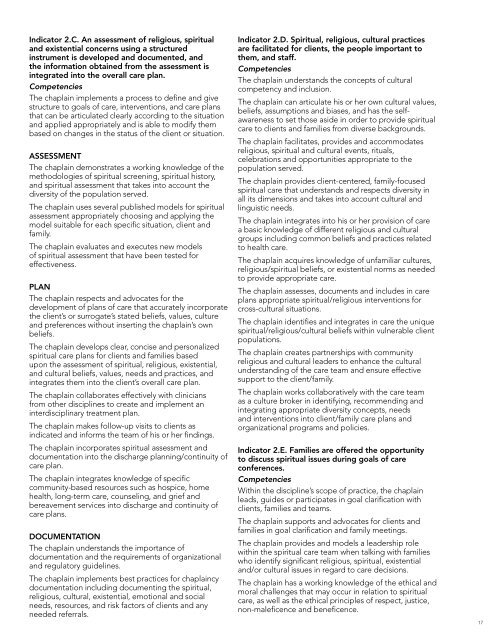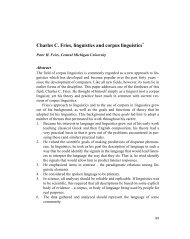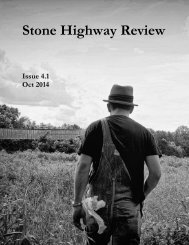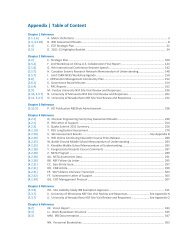TIME TO MOVE FORWARD
time_to_move_forward_report_2016-06-07
time_to_move_forward_report_2016-06-07
Create successful ePaper yourself
Turn your PDF publications into a flip-book with our unique Google optimized e-Paper software.
Indicator 2.C. An assessment of religious, spiritual<br />
and existential concerns using a structured<br />
instrument is developed and documented, and<br />
the information obtained from the assessment is<br />
integrated into the overall care plan.<br />
Competencies<br />
The chaplain implements a process to define and give<br />
structure to goals of care, interventions, and care plans<br />
that can be articulated clearly according to the situation<br />
and applied appropriately and is able to modify them<br />
based on changes in the status of the client or situation.<br />
ASSESSMENT<br />
The chaplain demonstrates a working knowledge of the<br />
methodologies of spiritual screening, spiritual history,<br />
and spiritual assessment that takes into account the<br />
diversity of the population served.<br />
The chaplain uses several published models for spiritual<br />
assessment appropriately choosing and applying the<br />
model suitable for each specific situation, client and<br />
family. <br />
The chaplain evaluates and executes new models<br />
of spiritual assessment that have been tested for<br />
effectiveness.<br />
PLAN<br />
The chaplain respects and advocates for the<br />
development of plans of care that accurately incorporate<br />
the client’s or surrogate’s stated beliefs, values, culture<br />
and preferences without inserting the chaplain’s own<br />
beliefs. <br />
The chaplain develops clear, concise and personalized<br />
spiritual care plans for clients and families based<br />
upon the assessment of spiritual, religious, existential,<br />
and cultural beliefs, values, needs and practices, and<br />
integrates them into the client’s overall care plan.<br />
The chaplain collaborates effectively with clinicians<br />
from other disciplines to create and implement an<br />
interdisciplinary treatment plan.<br />
The chaplain makes follow-up visits to clients as<br />
indicated and informs the team of his or her findings.<br />
The chaplain incorporates spiritual assessment and<br />
documentation into the discharge planning/continuity of<br />
care plan. <br />
The chaplain integrates knowledge of specific<br />
community-based resources such as hospice, home<br />
health, long-term care, counseling, and grief and<br />
bereavement services into discharge and continuity of<br />
care plans. <br />
DOCUMENTATION<br />
The chaplain understands the importance of<br />
documentation and the requirements of organizational<br />
and regulatory guidelines.<br />
The chaplain implements best practices for chaplaincy<br />
documentation including documenting the spiritual,<br />
religious, cultural, existential, emotional and social<br />
needs, resources, and risk factors of clients and any<br />
needed referrals. <br />
Indicator 2.D. Spiritual, religious, cultural practices<br />
are facilitated for clients, the people important to<br />
them, and staff.<br />
Competencies<br />
The chaplain understands the concepts of cultural<br />
competency and inclusion.<br />
The chaplain can articulate his or her own cultural values,<br />
beliefs, assumptions and biases, and has the selfawareness<br />
to set those aside in order to provide spiritual<br />
care to clients and families from diverse backgrounds. <br />
The chaplain facilitates, provides and accommodates<br />
religious, spiritual and cultural events, rituals,<br />
celebrations and opportunities appropriate to the<br />
population served.<br />
The chaplain provides client-centered, family-focused<br />
spiritual care that understands and respects diversity in<br />
all its dimensions and takes into account cultural and<br />
linguistic needs.<br />
The chaplain integrates into his or her provision of care<br />
a basic knowledge of different religious and cultural<br />
groups including common beliefs and practices related<br />
to health care.<br />
The chaplain acquires knowledge of unfamiliar cultures,<br />
religious/spiritual beliefs, or existential norms as needed<br />
to provide appropriate care. <br />
The chaplain assesses, documents and includes in care<br />
plans appropriate spiritual/religious interventions for<br />
cross-cultural situations. <br />
The chaplain identifies and integrates in care the unique<br />
spiritual/religious/cultural beliefs within vulnerable client<br />
populations. <br />
The chaplain creates partnerships with community<br />
religious and cultural leaders to enhance the cultural<br />
understanding of the care team and ensure effective<br />
support to the client/family. <br />
The chaplain works collaboratively with the care team<br />
as a culture broker in identifying, recommending and<br />
integrating appropriate diversity concepts, needs<br />
and interventions into client/family care plans and<br />
organizational programs and policies. <br />
Indicator 2.E. Families are offered the opportunity<br />
to discuss spiritual issues during goals of care<br />
conferences.<br />
Competencies<br />
Within the discipline’s scope of practice, the chaplain<br />
leads, guides or participates in goal clarification with<br />
clients, families and teams. <br />
The chaplain supports and advocates for clients and<br />
families in goal clarification and family meetings.<br />
The chaplain provides and models a leadership role<br />
within the spiritual care team when talking with families<br />
who identify significant religious, spiritual, existential<br />
and/or cultural issues in regard to care decisions. <br />
The chaplain has a working knowledge of the ethical and<br />
moral challenges that may occur in relation to spiritual<br />
care, as well as the ethical principles of respect, justice,<br />
non-maleficence and beneficence.<br />
17








